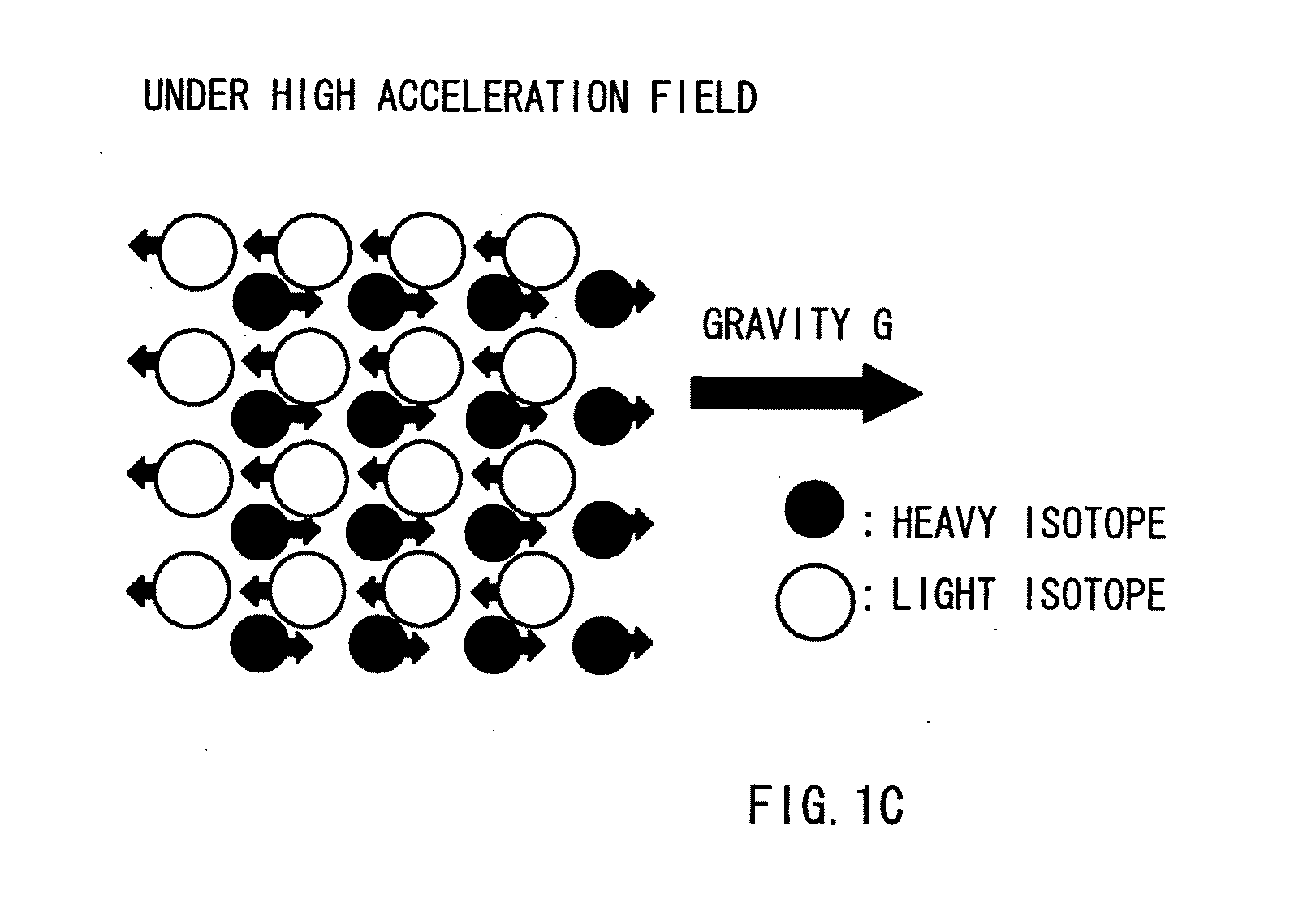Method for Separating and Enriching Isotope Material, Multistage Rotor, and Apparatus for Separating and Enriching Isotope Material
a technology of isotope material and multi-stage rotor, which is applied in the direction of sedimentation separation, solid-state diffusion coating, centrifugal force sedimentation separation, etc., can solve the problems of corrosive gas, inefficient methods, and hardly used in industrial manufacturing, and achieve cost reduction
- Summary
- Abstract
- Description
- Claims
- Application Information
AI Technical Summary
Benefits of technology
Problems solved by technology
Method used
Image
Examples
example 1
Simple Substance: Simple Se: Liquid and Solid
[0159]As an example that the material to be processed was a single metal, the case where single selenium (Se) was used was introduced. Natural Se was composed of isotopes such as Se (0.9%), Se (9.0%), Se (7.6%), Se (23.5%), Se (49.7%), Se (9.2%) and the like.
[0160]As a starting sample, grain sample of 4N—Se (meaning Se with a purity of 99.99%) was dissolved and solidified in a glass tube with an inner diameter of 5 mm under argon atmosphere, and the starting sample was cut as a cylindrical sample with a diameter of 5 mm and a length of 5 mm. A capsule of SUS304 with an inner diameter of 5 mm was filled with this, and the resultant was loaded on a rotor of Ti based alloy with a diameter of 80 mm (refer to FIG. 4).
[0161]In the experiment, an air-turbine type supercentrifuge in Japan Atomic Energy Agency, capable of generating a gravity field of 1,000,000 G (1 G=9.8 m / s2) or more over a long time at a high temperature was used. Two types of ...
example 2
[0172]As an example that the material to be processed was a solid solution, the case where selenium (Se)-tellurium (Te) alloy was used was introduced. As a starting sample, grain sample of 4N—Se, and 4N—Te (99.99%) was dissolved and solidified in a glass tube with an inner diameter of 4 mm under argon atmosphere, and the starting sample was cut as a cylindrical sample with a diameter of 4 mm and a length of 5 mm. A capsule of SUS304 with an inner diameter of 4 mm was filled with this.
[0173]In the experiment, an air-turbine type supercentrifuge in Japan Atomic Energy Agency, capable of generating a gravity field of 1,000,000 G (1 G=9.8 m / s2) or more for a long time at a high temperature was used. The experimental temperature was set at 260° C., and the experimental time was 100 hours. The analysis of the isotopes was performed by Institute for Study of the Earth's Interior, Okayama University which was located in Mitomo, Okayama Prefecture by using Cameca i...
example 3
Halides: Super-Ionic Conductor: Silver Iodide (AgI)
[0176]As an example that the material to be processed was a halide and super-ionic conductor, the case where silver iodide (AgI) was used was introduced (experiments 1, 2, and 3). Silver iodide (AgI) had a phase transition point from β-AgI to α-AgI at 148° C. α-AgI was a super-ionic conductor with a very-large diffusion coefficient (approximately 10−3 cm2 / s) of silver ion. The experimental temperature was set at 148° C. or more, and α-AgI was placed under the strong centrifugal acceleration field so that high-speed sedimentation phenomenon of Ag atoms in α-AgI might be expected. The experiment was conducted in consideration that the experimental temperature was set at 148° C. or less before removing the gravity so that the sample with the fixed isotope abundance ratio might be collected. The melting point was 555° C. In the experiment, an air-turbine type supercentrifuge in Japan Atomic Energy Agency, capable of generating a gravity...
PUM
| Property | Measurement | Unit |
|---|---|---|
| Angle | aaaaa | aaaaa |
| Magnetic field | aaaaa | aaaaa |
| Speed | aaaaa | aaaaa |
Abstract
Description
Claims
Application Information
 Login to View More
Login to View More - R&D
- Intellectual Property
- Life Sciences
- Materials
- Tech Scout
- Unparalleled Data Quality
- Higher Quality Content
- 60% Fewer Hallucinations
Browse by: Latest US Patents, China's latest patents, Technical Efficacy Thesaurus, Application Domain, Technology Topic, Popular Technical Reports.
© 2025 PatSnap. All rights reserved.Legal|Privacy policy|Modern Slavery Act Transparency Statement|Sitemap|About US| Contact US: help@patsnap.com



